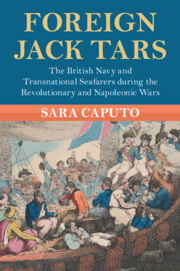 Foreign Jack Tars
Foreign Jack Tars 7 - Mercenaries, Migrants, and Refugees
Navy Crews as ‘Motley Crews’
from Part III - Displacement
Published online by Cambridge University Press: 03 November 2022
Summary
Chapter 7 reassesses our understanding of the social history of naval crews, by looking at their members’ degrees of geographical displacement. Being foreign ‘by provenance’, a transnational immigrant or refugee, conferred completely different weight and meaning to the terms of service: wages and victuals were evaluated by comparison with other fleets, and pensions and family remittances were only possible for those resident within British administrative reach. This chapter then reframes the historiographical debate on naval living and pay standards, situating the Navy in a transnational seafaring labour market. Some motivations for enlistment also elude the relatively neat dichotomy between ‘volunteer’ and ‘pressed man’ that has dominated British naval historiography: being ‘loaned’ by another monarch, or enslaver; escaping a British war prison, or enslavement; exile and contested loyalties. These personal circumstances only become visible when we look at Navy crews as ‘motley crews’, social and cultural mixtures of mobile and uprooted individuals often transcending the traditional image of the British ‘Jack Tar’, and very different from the modern model of citizen-serviceman. Labels of foreignness based on birthplace, subjecthood, or cultural difference were easily bypassed by naval efficiency and manpower maximisation, but the material aspects of social and geographical displacement were not.
Keywords
- Type
- Chapter
- Information
- Foreign Jack TarsThe British Navy and Transnational Seafarers during the Revolutionary and Napoleonic Wars, pp. 201 - 234Publisher: Cambridge University PressPrint publication year: 2022
